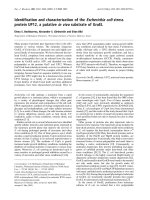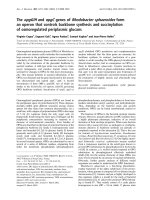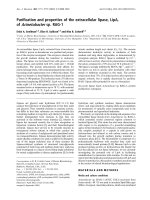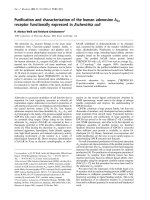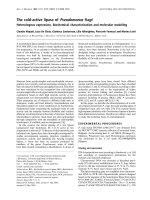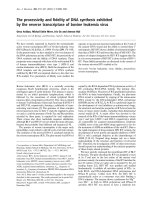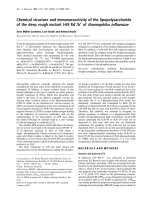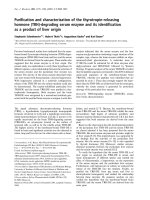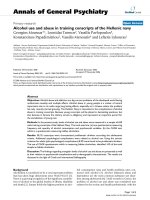Báo cáo y học: "The use and abuse of commercial kits used to detect autoantibodies" ppsx
Bạn đang xem bản rút gọn của tài liệu. Xem và tải ngay bản đầy đủ của tài liệu tại đây (111.47 KB, 10 trang )
192
ANA = antinuclear antibody; ANCA = antineutrophil cytoplasmic antibody; CPG = clinical practice guideline; EIA = enzyme immunoassay; ELISA =
enzyme-linked immunoassay; IIF = indirect immunofluorescence.
Arthritis Research & Therapy Vol 5 No 4 Fritzler et al.
Introduction
Over the past five decades, the detection of autoantibod-
ies in human sera has become an increasingly important
approach to the diagnosis and management of patients
with a variety of autoimmune conditions. The need for sup-
plies and reagents to perform these assays has become a
major entry point for manufacturers and commercial
vendors to develop and market a wide variety of diagnos-
tic kits. Although some diagnostic laboratories still use
assays that are developed in house, commercial kits have
gained a significant foothold in many areas of autoimmune
serology. The reasons that the use of commercial kits has
become so widespread are that they are cost-effective,
are easy to use and can satisfy criteria for accreditation.
Kits usually provide all the necessary reagents and a cook-
book approach to performance of the assay.
Commercial autoantibody assay kits employ a variety of
technologies that include indirect immunofluorescence
(IIF), immunodiffusion, immunoblotting, ELISA and, more
recently, addressable laser beads and antigen arrays. One
of the more popular technology platforms is based on the
ELISA because it offers sensitivity, high throughput and
relatively low cost on the background of only modest
equipment needed to perform the assay. Unfortunately,
little has been done to standardize these kits [1], and
postmarketing surveillance and quality assurance is largely
left to the manufacturers.
A number of studies have evaluated the performance char-
acteristics of antinuclear antibody (ANA) [2–13] and anti-
neutrophil cytoplasmic antibody (ANCA) [14] kits. Studies
that compared enzyme immunoassay (EIA) kits from differ-
ent manufacturers with conventional assays such as IIF
and immunodiffusion concluded that there was significant
discordance between conventional assays and EIAs [3,5]
and significant discordance between kits from different
manufacturers [4]. In one study EIAs were found to be
Review
The use and abuse of commercial kits used to detect
autoantibodies
Marvin J Fritzler
1
, Allan Wiik
2
, Mark L Fritzler
1
and Susan G Barr
1
1
Faculty of Medicine, University of Calgary, Alberta, Canada
2
Department of Autoimmunology, Statens Serum Institut, Copenhagen, Denmark
Correspondence: Marvin J Fritzler (e-mail: )
Received: 1 Apr 2003 Revisions requested: 29 Apr 2003 Revisions received: 1 May 2003 Accepted: 6 May 2003 Published: 9 Jun 2003
Arthritis Res Ther 2003, 5:192-201 (DOI 10.1186/ar782)
© 2003 BioMed Central Ltd (Print ISSN 1478-6354; Online ISSN 1478-6362)
Abstract
The detection of autoantibodies in human sera is an important approach to the diagnosis and
management of patients with autoimmune conditions. To meet market demands, manufacturers have
developed a wide variety of easy to use and cost-effective diagnostic kits that are designed to detect a
variety of human serum autoantibodies. A number of studies over the past two decades have
suggested that there are limitations and concerns in the use and clinical application of test results
derived from commercial kits. It is important to appreciate that there is a complex chain of users and
circumstances that contributes to variations in the apparent reliability of commercial kits. The goal of
this review is to identify the principal links in this chain, to identify the factors that weaken the chain and
to propose a plan of resolution. It is suggested that a higher level of commitment and partnership
between all of the participants is required to achieve the goal of improving the quality of patient care
through the use of autoantibody testing and analysis.
Keywords: autoantibodies, autoimmunity, diagnosis, diagnostic kits, quality assurance, standardization
193
Available online />more sensitive than immunodiffusion [2], and another
study that used a cross-section of serum referred to a
rheumatology laboratory found moderate to good agree-
ment between ANA-IIF and anti-DNA results with two
commercial EIA kits [6]. Analysis of the design of some
studies suggests that the lack of agreement between EIA
and conventional assays may depend on the diagnosis
and/or the selection bias of the patients under study
[2–4,6].
A study by Tan and colleagues [15] focused on the EIA
kits themselves, and in particular highlighted deficiencies
in intrinsic properties of the kits (sensitivities and specifici-
ties). A more recent study focused on the clinical laborato-
ries themselves and, although one might expect academic
laboratories to be rather proficient in the implementation of
the EIA kits, that was not the case [12]. As in other
studies [1], it was suggested that quality control proce-
dures for daily performance of tests in the clinical labora-
tory setting should not be ignored, and that a minimal
performance target of coefficients of variation in EIA
assays should be established [12].
If the conclusions of these studies can be briefly summa-
rized, it could be said that there are significant concerns
with the accuracy (sensitivity, specificity), reliability, and
quality of many commercial kits. In many cases the manu-
facturer has been assumed the root cause for these short-
comings; however, the use of commercial kits and their
appropriate application in a clinical setting involves a
rather complex chain of constituencies and events. The
factors that have disconnected the highly regulated and
good laboratory practices of the manufacturer and the
assumptions of the client clinician are numerous. The goal
of the present review is to identify the principal links in this
chain, to identify the factors that weaken the chain and to
propose a plan of resolution. It is suggested that a higher
level of commitment and partnership between all of the
participants is required to achieve the goal of improving
the quality of patient care through the use of autoantibody
testing and analysis.
The matrix of manufacturing and application
of autoantibody diagnostic kits (Fig. 1)
The delivery of health care in many countries has been
‘streamlined’ through consolidation of services, including
those provided by diagnostic laboratories. This has often
translated into higher workloads and increased pressure
to improve the interval between when the test is requested
and the time the test result is reported (turnaround time).
These factors have prompted and necessitated the search
for and adoption of economical, high-throughput assays.
This in turn has provided fertile soil for the germination and
growth of the diagnostic kit manufacturing and distributor
industries. Unfortunately, the rush for a product to solve
the problem of increasing throughput and decreasing
costs has lead to a fast track approach in the develop-
ment, the validation and the approval of commercial kits.
Regulatory agencies such as the Food and Drug Adminis-
tration in the USA, through the 510K approval mechanism,
have attempted to maintain a reasonable level of quality
before allowing the release and marketing of diagnostic
kits by manufacturers. At a minimum this has required
proof of performance that is often missing when diagnos-
tic laboratories develop and use inhouse assays. It is then
left to the diagnostic laboratories to evaluate the products
that are available and to make an ‘informed’ decision
about which kit is suited to that laboratory’s particular
environment so that cost–performance issues are ade-
quately addressed.
Downstream to the production, marketing, distributing,
adopting and performance of commercial kits are the
‘clients’ or physicians that are the drivers in this economy.
The availability of meaningful, accurate and dependable
assays is often assumed by the client who is acting on
behalf of the patient. Unfortunately, as many studies have
shown, the assumption of the client cannot be validated.
Manufacturers
In the area of autoantibody diagnostic kits there are at least
15 manufacturing companies involved worldwide. Those
with a significant market share are presented in Table 1.
Most manufacturers operate under a high level of security,
of scrutiny and of standardization, and under good labora-
tory practices and quality control. Many of these compa-
nies subscribe to and offer postmarketing quality
assurance programs. However, the threat of lost markets
becomes the driver that dictates continual changes to
enhance kit performance. This jockeying and marketing
strategy becomes a significant preoccupation. In this con-
Figure 1
The chain of production, use and application of autoantibody test kits.
194
Arthritis Research & Therapy Vol 5 No 4 Fritzler et al.
stantly changing environment, it is the responsibility of the
clinical diagnostic laboratory to assure that the day-to-day
and month-to-month performance of kits is adequate
because accreditation, reputation and payment for service
are at risk.
The manufacturer is, understandably, continually scanning
the horizon, looking for new technologies and new assays
that will give them a novel niche and marketing advantage.
Entry into these markets is rarely exclusive, so the challenge
is to manufacture a test kit that can be validated and can
adhere to regulatory controls (510K approval in the USA).
This then clears the pathway to market a kit that recovers
research and development costs, and hopefully makes a
profit. It is in the context of this activity that some problems
with kit performance occur because kit validation at this
level may not always live up to postmarketing performance.
The validation studies often include a collection of normal
and disease cohort sera obtained from a consulting clinician
or a clinical laboratory that are used in an internal evaluation
of kit performance and in establishing appropriate levels of
positive and negative boundaries. In this setting, the valida-
tion is often performed on state of the art equipment, using
the freshest reagents and kits just off the assembly line. A
second level of validation involves providing the kits to labo-
ratories that are willing and able (often without compensa-
tion) to ‘beta test’ the kit. If the results from the external beta
tests are in agreement with internal data, the kit is submitted
for approval by regulatory agencies and, having achieved
that, marketing and manufacturing begins.
Another source of variation is that manufacturers tend to
purchase kit components from a wide variety of suppliers
and that not all kit manufacturers use the same supplier.
The decision to produce or to purchase critical compo-
nents such as purified antigens and secondary antibodies
is based on cost and performance. When a reagent that
serves both of these features satisfactorily is found, manu-
facturers tend to buy large lots of these reagents to mini-
mize variability between production lots.
In summary, at the level of the manufacturer, the sources
of potential variability in the performance and quality of a
kit include the equipment used by the manufacturer to
evaluate the kit, the reagents and materials that are pur-
chased or manufactured to become components of the kit,
the reliability of the serum samples used to validate and
develop performance characteristics (cutoff points, upper,
middle and lower levels), and the stability of the final
product. The certification and regulatory systems under
which manufacturers operate are designed to minimize
variability in quality and performance of the assay. Clinical
evaluation is generally performed by expert laboratories
with defined patient samples that result in coefficients of
variation and receiver operator analyses to determine per-
formance characteristics.
Table 1
Autoantibody kit manufacturers and distributors
Manufacturer Location Website
Axis Shield Diagnostics Dundee, UK www.axis-shield.com
Biomedical Diagnostics Marne la Vallée, France www.bmd-net.com
Cambridge Life Sciences Cambridge, UK www.cambridgelifesciences.co.uk
Euro-Diagnostica Arnhem, Netherlands www.eurodiagnostica.com
Euroimmun AG Lubeck, Germany www.euroimmun.de
BioRad/Helix Diagnostics Hercules, CA, USA www.helixdx.com
IMMCO Diagnostics Buffalo, NY, USA www.immcodiagnostics.com
ImmunoConcepts Sacramento, CA, USA www.immunoconcepts.com
IMTEC Immundiagnostika Zepernick, Germany www.imtec-berlin.de
INOVA Diagnostics Inc. San Diego, CA, USA www.inovadx.com
Medical and Biological Laboratories Co. Ltd Nagoya, Japan www.mbl.co.jp
ORGENTEC Diagnostika GmbH Mainz, Germany www.orgentec.com
Pharmacia Peapack, NJ, USA www.pharmacia.com/products/diagnostics.asp
Wieslab AB Lund, Sweden www.wieslab.se
Zeuss Scientific Inc. Raritan, NJ, USA www.zeusscientific.com
195
Available online />Health care underwriter
The health care underwriter or paymaster (health insur-
ance companies, government-based health care systems)
is often regarded as the weakest link in the chain. Their
admirable goal is to improve quality of care while con-
straining health care costs, but there are widespread con-
cerns among health care economists that this may be
unachievable. For example, as much as 80% of health
care costs occur in the final 2–3 years of the patients’
lives. The principles of cost-containment are often trans-
mitted to diagnostic laboratory services that include the
laboratories conducting the autoantibody testing. In
response, the diagnostic laboratory tries to find a kit that
offers the highest throughput on the background of lowest
cost. In effect, the quality of the kit can become a sec-
ondary or even tertiary consideration. To complicate things
further, when a new technology that achieves higher accu-
racy comes along it cannot be adopted because cost con-
straints are the major driver.
In fairness to health care underwriters, although the costs
of laboratory diagnostic studies can easily be calculated,
very little is known about the actual costs incurred through
inappropriate laboratory testing. In Scandinavia, the esti-
mated cost of all types of in vitro laboratory diagnostic
testing is 2–3% of the total health care budget. In some
jurisdictions, diagnostic imaging techniques and other rel-
atively invasive procedures are being used much earlier in
patient evaluations in spite of their much higher expense.
Frequently, their clinical value with regard to the long-term
prognosis has not been clearly elucidated.
Since early diagnosis is thought to be a key factor in
outcome, and hence downstream health care costs, it is
reasonable to assume that health care providers might
want to ensure that funds are available for this important
aspect of ‘preventative medicine’. In light of the significant
health care (renal dialysis, stroke and cardiovascular
events, musculoskeletal rehabilitation) and consumer
expense (lost wages, decreased productivity) that attends
the delayed diagnosis of a systemic rheumatic disease, it
is difficult to understand why low-cost and high-quality
autoimmune serology is not given a higher priority by the
health care system.
It is appreciated that inappropriate laboratory testing (e.g.
indiscriminate panel testing) is both costly and potentially
misleading in the diagnostic workup. An estimation of
long-term costs related to early accurate diagnosis and
therapeutic intervention compared with a missed or wrong
diagnosis with or without treatment is required to reinforce
the value of high-quality laboratory diagnostic. This begs
another question, however: What are the costs attended
by not providing the best possible autoantibody diagnostic
service possible? The significant lag time in recognizing and
budgeting for useful new analytes such as Saccharomyces
cerivisiae, tissue transglutaminase, cyclic citrullinated
peptide and chromatin are among recent examples that
are of concerns to clinicians.
Clinical diagnostic laboratory
The clinical diagnostic laboratory is usually dependent on
the integrated and optimal performance of a number of
individuals that perform different tasks, ranging from the
laboratory manager, to the clinical laboratory specialist
(usually a clinical laboratory immunologist with a PhD or
MD degree and/or certification qualifications), to the tech-
nologist and support staff that handle the specimens and
perform the assay. As noted earlier, the decision to adopt
a particular kit is often based on fiscal matters and is left
to the discretion of the manager in consultation with the
laboratory specialist.
In a biomedical world where knowledge and highly spe-
cialized technologies are rapidly expanding and special-
ized products are being produced, the clinical laboratory
specialist is expected to be an expert. It does not take
much introspection to appreciate that, if you were the
patient or physician, you would much prefer the diagnostic
results from a laboratory that had the highest level of
expertise in your particular disease and the technologies
relevant to that disease. Laboratory clinicians are doing
their best to maintain and advance their level of compe-
tence, while carrying out burdensome and necessary
quality assurance and accreditation standards. Meanwhile
the industry is advancing quickly to adapt, to modify, and
to advance diagnostic technologies as well as offer new
diagnostic kits to make the laboratory clinician’s life more
manageable.
The characteristics of diagnostic laboratories that perform
well are not clearly understood. Even though manufactur-
ers provide clear directions on how to optimally use their
kit and perform a certain assay, some laboratories adapt
kits to their own protocols [12]. Some studies have shown
that when the laboratories are a part of, or affiliated with,
academic institutions they might perform better, but this is
not always the case [12]. It is clear that laboratories that
perform well engage in a process of internal validation of
new kits before they are adopted. However, clinically
defined serum samples are a rare commodity and make
the evaluation process that much more difficult. As noted
earlier, new assays are frequently marketed before it has
been demonstrated that their diagnostic specificity has
not suffered due to attempts to increase sensitivity. Even
in ideal manufacturing circumstances after internal evalua-
tions and external beta testing, the capability of the assay
to accurately predict a specific diagnosis is not fully
known. Therefore, it is incumbent on the clinical diagnostic
laboratory to evaluate each new kit with test sera from
local patients with inflammatory rheumatic diseases. This
process needs to be attended by close collaboration of
196
diagnostic laboratories, by experienced clinicians who
strive for an accurate diagnosis and by patients that will-
ingly donate their blood for testing and research purposes.
Screening sera for ANA by ELISA plates that have
adsorbed complex mixtures of native and/or recombinant
autoantigens or nuclear extracts is used by many laborato-
ries instead of screening ANA by IIF on HEp-2 or other
substrates. A considerable body of data shows that a sig-
nificant proportion of sera from Sjögren’s syndrome, from
scleroderma and from polymyositis/dermatomyositis score
negative using composite ANA-ELISA techniques [16,17].
Further examination of these false-negative sera by IIF
screening reveals that they contain antibodies to nucleolar
components, nuclear matrix, proliferating cell nuclear
antigen, nuclear envelope and nuclear pore complexes,
coiled bodies, promyelocytic leukemia domains,
SS-A/Ro 52, centromeres and other mitotic spindle appa-
ratus antigens, as well as a variety of cytoplasmic
organelles and structures (e.g. mitochondria, Golgi appa-
ratus, endosomes, a signal recognition particle or ribo-
somes) [18].
Many of these autoantibodies are readily recognized by IIF
techniques when experienced technicians read the slides
[16], and there is a growing body of evidence showing
that these autoantibodies are useful in clinical diagnostics
[19]. A recent study that found false negative results when
systemic rheumatic disease sera were screened by an
ANA-ELISA suggested that this test should still be used
as a screening test and that negative sera could then be
tested by the IIF technique [17]. A problem with this
approach is that sera from patients with systemic
rheumatic diseases commonly have multiple autoantibod-
ies, including antibodies to antigens not found in the ANA-
ELISA. Since many of these autoantibodies have clinical
and diagnostic relevance, this approach would provide
ANA results that could be misleading and the approach
would lack uniformity with respect to all sera tested. Fur-
thermore, the need to perform a second test on negative
sera has the potential to add significant costs to laboratory
operations. Until further improvements in the ANA-screen-
ing ELISA can be achieved, IIF-ANA should be considered
the gold standard [4,6,16,20]. A problem with both IIF and
the ELISA, and other assays, is represented by sera that
give borderline or weakly positive results, making the clini-
cal utility of the test of questionable value.
Once a kit is selected and internally validated, presumably
through a combination of effective marketing and internal
validation of performance of a sample kit, the diagnostic
laboratory embarks on an adventure that is fraught with
even more potential problems. The first is the equipment
used to perform the test. This includes the entire spectrum
of equipment, but of pivotal importance are the micro-
scopes used for IIF and the spectrophotometers and plate
readers used for ELISA. These instruments vary in perfor-
mance, not only with respect to intralaboratory configura-
tions, but also with respect to interlaboratory
configurations. A key element related to microscopy is the
use of a transmitted UV light source rather than incident
(epifluorescence) light. In addition, the quality of micro-
scope objective lenses (numerical aperture) varies from
manufacturer to manufacturer, and the choice of objec-
tives is often dictated by cost. Some laboratories use oil
immersion objectives while others insist that dry objectives
are adequate. Some laboratories use their own mounting
medium and cover slips even when these are supplied as
components of kits.
ELISA and dot blot kits are likewise victimized by equip-
ment that bears little resemblance to the equipment used
by manufacturers for production, and they have varying
capacity and photonics. In addition, equipment is becom-
ing more sophisticated, which generally results in assays
becoming more sensitive. As that occurs, the diagnostic
specificity decreases and cutoff points must be adjusted.
For years it was thought that the cutoff point and appropri-
ate screening dilution for ANA on HEp-2 substrates was
1/40 or 1/80. However, after a multicenter study showed
that 32% of normal sera were positive at 1/40, it was rec-
ommended that a cutoff point of 1/160 is more appropri-
ate [21].
Variations in equipment are compounded when the test
requires a subjective assessment by the technologist or
laboratory immunologist, leading to a wide range of
results. A typical example of this variation is the discrepant
results that may occur when a technologist performs and
interprets the results one day and a different technologist
in the same laboratory performs and interprets the results
on weekends. It might be concluded that this results in a
complete breakdown of interlaboratory and intertest per-
formance. Thankfully, that is not always the case because,
despite these variables, performance characteristics might
be considered remarkably high. This is in large part due to
quality assurance and accreditation programs (Table 2).
One of the key problems in the interpretation of the ANA
result is the content and design of the test report. The
information contained in a report varies tremendously from
laboratory to laboratory. Even when the same kits are used
to perform a test, different laboratories generate very dif-
ferent reports. Clinicians must be able to understand the
reported results without having to pore over the report and
‘read between the lines’. If the report is not easily under-
stood, it can be erroneously interpreted or the clinician
may take unnecessary time to contact the laboratory to
request an interpretation or may file the report as useless
information. The results must be clearly expressed and
must be an indication of whether they represent a high,
moderate, low, borderline or negative result.
Arthritis Research & Therapy Vol 5 No 4 Fritzler et al.
197
In most cases, there is little clinical value in reporting
numerical results such as the optical density values for
ELISA. Clinicians usually want to know whether the result
is positive, whether it is highly abnormal or borderline, and
what a general interpretation of the result might be. Some
laboratories also provide current literature references to
support the result so that clinicians can inform themselves
further if they desire. When an autoantibody is found, the
positive result is communicated to the clinician as a
printed report or as a secured digital report sent directly to
the doctor. Other general information to aid in the interpre-
tation, such as the sensitivity and specificity of a positive
result, should be tabulated in a printed or an Internet-
based guide or handbook.
Physician
The test has been ordered and the result is reported. Now
comes the next critical event in the chain: interpretation of
the result. Many factors contribute to how a test is inter-
preted. First and foremost, the result must be interpreted in
the context of the patient’s symptoms and/or clinical find-
ings. An autoantibody test on its own rarely establishes a
diagnosis because systemic rheumatic diseases involve
multiple organ systems and, particularly early in the disease
course, there is rarely a pathogonomic feature. Multiple cri-
teria have therefore been developed and must be fulfilled to
confirm a particular diagnosis. Importantly, each disease is
associated with different autoantibody profiles and specifici-
ties [22–27], and there are ongoing efforts to develop
improved criteria for particular groups of patients. The goal
is to increase the likelihood that a diagnosis or tentative
classification of the disease is correct. The more knowl-
edgeable the clinician is with regards to the clinical and lab-
oratory characteristics of diseases, the greater the chance
that a diagnosis is correct. To achieve this physicians are
encouraged, and in some countries are required, to maintain
a high level of competence through continuing education.
A survey of physicians showed that advances in diagnos-
tic testing were regarded as among the most significant
medical innovations in recent years [28]. With the prolifer-
ation of diagnostic tests, however, clinical interpretations
and decisions have become more complex. The physician
finds it imperative to decide on the best test for a patient
and, at the same time, to consider the best sequence of
tests that follow. The need for a practical, evidence-based
and reasoned approach for diagnostic testing has never
been greater. Hence, clinical practice guidelines (CPGs)
are needed for a rational, judicious and economic use of
serologic testing [29–33].
A large number of variables must be considered before
CPGs are developed. First, CPGs should take into full
account evidence-based research. Second, CPGs should
be based on consensus of experts in the field. The conclu-
sions in some studies are dependent on the quality of the
data, and it is necessary to develop inclusion and exclusion
criteria to evaluate a large body of data [29]. The value and
application of conclusions based on a grouped literature
review in the setting of rapidly changing technology is open
to debate. There is no point in developing CPGs when
high-performance laboratories are grouped with poor per-
formance laboratories. Finally, the application of CPGs is
difficult to apply in all settings. In small laboratories and
clinical service environments it is easier to achieve consen-
sus on testing strategies than it is for large laboratories that
provide service to more extensive populations.
A CPG may include a guide to clinicians suggesting
which screening tests should be used for a particular
patient with a tentative diagnosis (Fig. 2 and Table 2) and
those tests that are useful to monitor disease activity or
progression. This guide also provides a flow diagram of
tests that are necessary to support a diagnosis and esti-
mate prognosis. A positive screening test may lead to the
referral of a patient to a specialist, who will then initiate
further serological testing. It is important to realize that the
pretest probability of detecting a useful diagnostic labora-
tory result increases with each clinical feature that has
been incorporated into the tentative diagnosis [34].
Autoantibodies that occur in one disease, and thus are
regarded as disease-specific markers, tend to be rare
[19]. Autoantibodies that were previously assumed to
relate specifically to one disease are now found to be
associated with a variety of autoimmune diseases [35].
Data related to certain autoantibodies and their disease
specificity relied on old technology and on studies pub-
lished several decades ago that may be outdated and may
need revision. In addition, the presence of multiple
disease-related autoantibodies occurring in a single serum
(antibody profile) may be more indicative that a certain
diagnosis is correct than the presence of a single antibody
[19,36]. Another controversy arises when discrepant
results are obtained by different anti-double-stranded DNA
assays, or when a positive anti-double-stranded DNA
result is reported for a serum that is negative on the
HEp-2 substrate [37–39]. Accordingly, the strengths and
shortcomings of new tests must be monitored and there
must be agreement on how to interpret discrepant results
before the test is introduced for clinical use. Positive or
negative results that are out of context with known clinical
parameters suggest that a test system may be unreliable
and requires re-evaluation. These issues all emphasize the
importance of developing CPGs that are current and in
tune with conventional autoantibody testing.
Finally, physicians should be aware of the performance
issues raised in previous studies [12]. They should be
involved in these issues by asking their laboratory director
how that laboratory assesses its own performance and the
performance of the commercially available testing systems.
Available online />198
Patient
The ongoing demands of quality control and quality assur-
ance are highly dependent on the availability of prototype
sera and on the participation of patients who are willing to
donate blood. The serum from patients with ‘monospecific’
and ‘polyspecific’ autoantibody reactivity is critical in
research and development of new diagnostics products.
There appears to be increasing reluctance of patients to
participate because of concerns about confidentiality that
have been complicated by heightened awareness of mis-
adventures reported in the press. Equally important is the
long-term participation of patients in clinical studies so
that the accurate and reliable correlations of diagnostic
markers to clinical outcome can be studied and validated.
The difficulties in obtaining and exchanging human sera
have been increased in many jurisdictions because of
reluctant human ethics research boards.
Institutional ethics review boards
In the past decade, ethics review boards have become a
pivotal part in the participation of patients in efforts to
maintain quality control, quality assurance, the genera-
tion of clinical practice guidelines and the development
of better diagnostic kits. The ability to obtain and
exchange patient sera between manufacturers and labo-
ratories that are involved in ANA kit development and
monitoring has become increasingly difficult. In some
cases, this has come to a complete halt because of
increasing paranoia and intrusion of ethics review
boards. There is a critical need to achieve a much higher
level of understanding between the parties concerned so
that a more balanced approach can be taken. The key
issues of patient confidentiality and protection of identity
are often used as a reason that exchange of sera or par-
ticipation in protocols cannot be approved. There is no
reason for this, since the identity of the individual is not
required for these studies. The next critical issue
appears to be the compiling and communication of clini-
cal information (age, gender, race, social and family
history, clinical and laboratory parameters). This should
not constitute a break in confidentiality if the anonymity
of the patient is guaranteed.
Arthritis Research & Therapy Vol 5 No 4 Fritzler et al.
Figure 2
A clinician’s guide to autoantibody test requests.
TENTATIVE DIAGNOSIS
SLE SjS SSc MCTD PM/DM RA APS
SVV
Autoantibody
ANA IIF 1 1 1 1 1 1 1
—
dsDNA 2 2 3 2 3 3 2
—
Sm 2 2 3 2 3 — 2
—
U1 RNP 2 2 2 2 2 — —
—
SSA/SSB 2 2 3 — — 3 —
—
Rib P 2 — 3 3 — — —
—
Scl-70 — — 2 3 3 — —
—
RNA Pol I/III — — 2 3 3 — —
—
Jo-1 — — — 3 2 — —
—
aCL 2 3 3 3 3 3 1
3
β2GPI
3——— — — 1
—
IgM RF 3 3 — 3 — 1 —
—
CP — — — 3 — 1 —
—
ANCA/IIF ———— — — —
1
PR3 cANCA — — — — — — —
2
MPO pANCA
———— — — — 2
Code: 1=screening test
2=follow-up test
3=optional test depending on clinical picture
— = not indicated
Abbreviations: aCL, anti-cardiolipin; ANA, antinuclear antibody; ANCA, antineutrophil
cytoplasmic antibody; APS, anti-phospholipid syndrome; CP, citrullinated peptide; DM,
dermatomyositis; dsDNA, double stranded DNA; IIF, indirect immunofluorescence; Jo-1,
histidyl tRNA synthetase; MPO, myeloperoxidase; PM, polymyositis; Pol, polymerase;
PR 3, proteinase 3; RA, rheumatoid arthritis; Rib P, ribosomal P proteins; RF,
rheumatoid factor; SLE, systemic lupus erythematosus; Scl-70, topoisomerase I; SjS,
Sjögren’s syndrome; Sm, Smith; SSA/SSB, Sjögren’syndrome antigen A (Ro), B (La);
SSc, s
y
stemic sclerosis: SVV, small vessel vasculitis
199
Available online />Table 2
Recommendations for problem areas in antinuclear antibody kit use and application
Principal Problem Recommendations
Manufacturer Variable reagents and analytes Standardized or common sources of reagents and analytes
Variable secondary antibodies Standardized or common sources of secondary antibodies
Premarketing, beta testing and selling kits Wider testing in clinical laboratories before marketing and selling
Quality control and postmarketing surveillance Willingness and ability to adjust and to improve kit performance
Clinical laboratory Equipment Upgrading and use of equipment to standards
Protocols and standard operating procedures Follow manufacturer’s protocols
Utilize international reference sera
Utilize local sera from clinically defined and normal controls to assess
performance of kit before adopting into practice
Training and maintenance of competence Technologist required to demonstrate competence and to participate in
appropriate educational forums
Test requisitions and reports Should be clear and concise
Provide clear algorithm of tests provided and approach to use (Fig. 2)
Design and adopt a universal format
Report graded positive results when appropriate or give clinically meaningful
cutoff
Physician liaison Staff with specific skills serve as primary physician liaison to provide advice
and to assist with test interpretation
Physician Ordering tests Aware of clinical laboratory capabilities
Utilize graded approach to ordering tests (Figure 2)
Receiving tests In cooperation with ethics boards, move to digital or electronic receipt of test
results while maintaining patient confidentiality
Interpreting result If result not understood contact physician liaison at laboratory
Communication of results Timely action after report received because diseases can progress rapidly
Patient advocate and educator If appropriate, enquire about patient’s willingness to participate in research
Seek informed consent
Patient Accurate historian Possess and protect record of current medical history and record important
symptoms
Participation Consider participation in research studies
Review and provide signed informed consent
Allow serum to be used for research
Regulatory bodies Quality assurance Attention to quality of samples provided for ongoing quality assurance
programs
Utilize international standards and reference sera
Health care Budgeting Ensure that budget keeps pace with appropriate advances in
underwriters serology
Support the use of tests that have been proven to have an impact on patient
care and outcome
Alignment of services Ensure that laboratory services are optimized
Consider impacts of laboratory consolidation on quality of care
200
Arthritis Research & Therapy Vol 5 No 4 Fritzler et al.
How can patient anonymity be guaranteed? In the past,
many laboratories engaged in the development of diag-
nostic kits have acquired sera through a number of chan-
nels: physicians, service providers, exchange from other
laboratories. The concern that samples include information
that could directly identify a patient is easily resolved when
the primary source of the sera ‘strips’, codes and repack-
ages the serum sample that is then stored or transmitted
for these studies. In the setting of most modern clinical
databases, key information such as age, gender, race,
diagnosis or international classification of disease codes
can readily be extracted without breach of confidentiality.
In many centers this may require reorganization of sample
collection, but given the constraints implied in protection
of patient confidentiality there are few options. Finally, in
contemporary clinical environments, it is highly recom-
mended that each patient be asked to sign a consent form
that will permit their serum and plasma to be used for
research and development.
Regulatory and quality assurance agencies
Both the industry and diagnostic laboratories have access
to and utilize a set of standardized sera provided by the
International Union of Immunology Societies/Arthritis
Foundation/World Health Organization/Center for Dis-
eases Control Serology Committee and made available
through the Center for Diseases Control in Atlanta [40].
The reference sera available through this program are con-
tinuously monitored and are currently being expanded to
include antibodies to cardiolipin, fibrillarin, RNA poly-
merase I/III, ribosomal P proteins, and c-ANCA and
p-ANCA. At this time standardized secondary antibodies
are not widely available. Also, sera used as standards for a
particular methodology need re-evaluation from time to
time, as exemplified by the re-evaluation of Arthritis Foun-
dation/Center for Diseases Control reference sera for
immunoblotting purposes [41].
Many laboratories are required to participate in a number of
improvement and quality assurance programs such as that
administered by the College of American Pathologists
(www.cap.org). The Clinical Laboratory Improvement
Amendments of 1988 set standards for all laboratories
engaged in clinical testing. These standards include require-
ments for trained and competent supervisory and testing
personnel, for record keeping and instrument maintenance,
for daily quality control practices, for result reporting, and for
laboratory inspection and maintenance. It is not clear that
these standards are being met in routine practice.
An interesting model of mandatory quality assurance and
proficiency testing was initiated in France in 1998. This
program is administered and implemented by the French
Health Products Safety Agency. Serum samples that have
achieved consensus testing results in up to nine reference
laboratories are distributed annually. The quality assess-
ment division of the Agency monitors all clinical laborato-
ries through a computer database, so that the reported
results can be related to the tests performed by each labo-
ratory. After the distribution of a serum sample, the results
are collated and a statistical evaluation is undertaken, cul-
minating in an individual report. This permits each partici-
pant to verify the accuracy and precision of their results
and to compare them with reference values.
Conclusions and summary
The principal goal of a clinician is to obtain an early and
accurate diagnosis in patients that can present with a
wide variety of symptoms and signs during development,
progression or regression of systemic rheumatic and other
autoimmune conditions. Over the past two decades, com-
mercial autoantibody assay kits have had a tremendous
impact on achieving this goal. However, there are still sig-
nificant challenges in the manufacture, the marketing, and
the clinical application of commercial autoantibody assay
kits. Table 2 summarizes some of the principal issues that
are discussed in the present review and that are believed
to limit the effective use of commercial autoantibody
detection kits. Certain actions are proposed so that there
can be resolution of some of the current shortcomings and
challenges. To achieve a higher level of effectiveness will
require a commitment and coordination of all organizations
and individuals in the network (Fig. 1).
Competing interests
Marvin Fritzler is a consultant to ImmunoConcepts Inc.,
Sacramento, CA
References
1. Feltkamp TEW: Antinuclear antibody determination in a routine
laboratory. Ann Rheum Dis 1996, 55:723-727.
2. Jaskowski TD, Schroder C, Martins TB, Mouritsen CL, Hill HR:
Comparison of three commercially available enzyme
immunoassays for the screening of autoantibodies to
extractable nuclear antigens. J Clin Lab Anal 1995, 9:166-172.
3. Jaskowski TD, Schroder C, Martins TB, Mouritsen CL, Litwin CM,
Hill HR: Screening for antinuclear antibodies by enzyme
immunoassay. Am J Clin Pathol 1996, 105:468-473.
4. Emlen W, O’Neill L: Clinical significance of antinuclear antibod-
ies: comparison of detection with immunofluorescence and
ELISA. Arthritis Rheum 1997, 40:1612-1618.
5. Fawcett PT, Rose CD, Gibney KM, Emerich MJ, Athreya BH,
Doughty RA: Use of ELISA to measure antinuclear antibodies
in children with juvenile rheumatoid arthritis. J Rheumatol
1999, 26:1822-1826.
6. Ulvestad E, Kansetrom A, Madland TM, Thomasse E, Haga HJ,
Vollset SE: Evaluation of diagnostic tests for antinuclear anti-
bodies in rheumatological practice. Scand J Immunol 2000,
52:309-315.
7. Bossuyt X: Evaluation of two automated enzyme immunoas-
says for detection of antinuclear antibodies. Clin Chim Lab
Med 2000, 38:1033-1037.
8. Jansen EM, Deng J, Beutner EH, Kumar V, Chorzelski TP: Com-
parison of commercial kits for the detection of anti-nDNA
antibodies using Crithidia lucilae. Am J Clin Pathol 1987, 87:
461-469.
9. Avina-Zubieta JA, Galindo-Rodriguez G, Kwan-Yeung L, Davis P,
Russell AS: Clinical evaluation of various selected ELISA kits
for the detection of anti-DNA antibodies. Lupus 1995, 6:370-
374.
201
Available online />10. Cordiali FP, D'Agosto G, Ameglio F, Valesini G, Alessandri C,
Farsi A, Domenighetti MP, Passaleva A, Scamardella F, Neri R,
Bombardieri S, Quinzanini M, Franceschini F, Chiarotti F: Deter-
mination of antibodies to extractable nuclear antigens by
commercial kits: a multicenter study. Int J Clin Lab Res 1998,
28:29-33.
11. Kern P, Kron M, Hiesche K: Measurement of antinuclear anti-
bodies: assessment of different test systems. Clin Diagn Lab
Immunol 2000, 7:72-78.
12. Fritzler MJ, Wiik A, Tan EM, Smolen JS, McDougal JS, Chan EKL,
Gordon TP, Hardin JA, Kalden JR, Lahita RG, Maini RN, Reeves
WH, Rothfield NF, Takasaki Y, Wilson M, Byrd M, Slivka L, Koziol
JA: A critical evaluation of enzyme immunoassay kits for
detection of antinuclear antibodies of defined specificities. III.
Comparative performance characteristics of academic and
manufacturers’ laboratories. J Rheumatol 2003, in press.
13. Bizzaro N, Tozzoli R, Tonutti E, Piazza A, Manoni F, Ghirardello A,
Bassetti D, Villalta D, Pradella M, Rizzotti P: Variability between
methods to determine ANA, anti-dsDNA and anti-ENA autoan-
tibodies: a collaborative study with the biomedical industry. J
Immunol Methods 1998, 219:99-107.
14. Csernok E, Ahlquist D, Ullrich S, Gross WL: A critical evaluation
of commercial immunoassays for antineutrophil cytoplasmic
antibodies directed against proteinase 3 and myeloperoxi-
dase in Wegener’s granulomatosis and microscopic polyangi-
itis. Rheumatology (Oxford) 2002, 41:1313-1317.
15. Tan EM, Smolen J, McDougal JS, Butcher BT, Conn D, Dawkins
R, Fritzler MJ, Gordon T, Hardin JA, Kalden JR, Lahita RG, Maini
RN, Rothfield NF, Smeenk RJ, Takasaki Y, Van Venrooij WJ, Wiik
A, Wilson MR, Koziol JA: A critical evaluation of enzyme
immunoassays for the detection of antinuclear antibodies of
defined specificities. I. Precision, sensitivity and specificity.
Arthritis Rheum 1999, 42:455-464.
16. Bayer PM, Bauerfeind S, Bienvenu J, Fabien N, Frei PC, Gilburd
B, Heide KG, Hoier-Madsen M, Meroni PL, Monier JC, Monneret
G, Panzeri P, Shoenfeld Y, Spertini F, Wiik A: Multicenter evalu-
ation study on a new HEp2 ANA screening enzyme immune
assay. J Autoimmun 1999, 13:89-93.
17. Bayer PM, Fabian B, Hubl W: Immunofluorescence assays
(IFA) and enzyme-linked immunosorbent assays (ELISA) in
autoimmune disease diagnostics — technique, benefits, limi-
tations and applications. Scand J Clin Lab Invest Suppl 2001,
235:68-76.
18. Wiik A: Testing for ANA and ANCA — diagnsotic value and pit-
falls. In Rheumatology. London: Mosby; 2003.
19. von Muhlen CA, Tan EM: Autoantibodies in the diagnosis of
systemic rheumatic disease. Semin Arthritis Rheum 1995, 24:
323-358.
20. Rondell JMM, Van Gelder M, Van der Leeden H, Dinkelaar RB:
Different strategies in the laboratory diagnosis of autoim-
mune disease: immunofluorescence, enzyme-linked immuno-
sorbent assay or both? Ann Clin Biochem 1999, 36:189-195.
21. Tan EM, Feltkamp TEW, Smolen JS, Butcher B, Dawkins R, Frit-
zler MJ, Gordon T, Hardin JA, Kalden JR, Lahita RG, Maini RN,
McDougal JS, Rothfield NF, Smeenk RJ, Takasaki Y, Wiik A,
Koziol JA: Range of antinuclear antibodies in ‘healthy’ individu-
als. Arthritis Rheum 1997, 40:1601-1611.
22. Targoff IN: Laboratory testing in the diagnosis and manage-
ment of idiopathic inflammatory myopathies. Rheum Dis Clin
North Am 2002, 28:859-890, viii.
23. Ho KT, Reveille JD: The clinical relevance of autoantibodies in
scleroderma. Arthritis Res Ther 2003, 5:80-93.
24. Cervera R, Khamashta MA, Font J, Sebastiani GD, Gil A, Lavilla P,
Domenech I, Aydintug AO, Jedryka-Goral A, de Ramon E,
Galeazzi M, Haga HJ, Mathieu A, Houssiau F, Ingelmo M, Hughes
GR: Systemic lupus erythematosus: clinical and immunologic
patterns of disease expression in a cohort of 1,000 patients.
Medicine 1993, 72:113-124.
25. Wiik A: Clinical use of serological tests for antineutrophil cyto-
plasmic antibodies. What do the studies say? Rheum Dis Clin
North Am 2003, 27:799-813.
26. Permin H, Hørbov S, Wiik A, Knudsen JV: Antinuclear antibodies
in juvenile chronic arthritis. Acta Paediatr Scand 1978, 67:181-
185.
27. Rosenberg AM: The clinical associations of antinuclear anti-
bodies in juvenile rheumatoid arthritis. Clin Immunol
Immunopathol 1988, 49:19-27.
28. Chugani DC, Rome LH, Kedersha NL: Evidence that vault
ribonucleoprotein particles localize to the nuclear pore
complex. J Cell Sci 1993, 106:23-29.
29. Solomon DH, Kavanaugh AJ, Schur PH: Evidence-based guide-
lines for the use of immunologic tests: antinuclear antibody
testing. Arthritis Rheum 2002, 47:434-444.
30. Kavanaugh AF, Solomon DH: Guidelines for immunologic labo-
ratory testing in the rheumatic diseases: anti-DNA antibody
tests. Arthritis Rheum 2002, 47:546-555.
31. Kavanaugh A: The utility of immunologic laboratory tests in
patients with rheumatic diseases. Arthritis Rheum 2001, 44:
2221-2223.
32. Smolen JS, Steiner G, Tan EM: Standards of care: the value
and importance of standardization. Arthritis Rheum 1997, 40:
410-412.
33. Tozzoli R, Bizzaro N, Tonutti E, Villalta D, Bassetti D, Manoni F,
Piazza A, Pradella M, Rizzotti P: Guidelines for the laboratory
use of autoantibody tests in the diagnosis and monitoring of
autoimmune rheumatic diseases. Am J Clin Pathol 2002, 117:
316-324.
34. Keren DF, Nakamura RM: Progress and controversies in
autoimmune disease testing. Clin Lab Med 1997, 17:483-497.
35. Van Eenennaam H, Vogelzangs JHP, Bisschops L, Te Boome LCJ,
Seelig HP, Renz M, De Rooij DJ, Brouwer R, Pluk H, Pruijn GJM,
Van Venrooij WJ, van den Hoogen FHJ: Autoantibodies against
small nucleolar ribonucleoprotein complexes and their clinical
associations. Clin Exp Immunol 2002, 130:532-540.
36. Blass S, Engel J-M, Burmester GR: The immunologic homuncu-
lus in rheumatoid arthritis. Arthritis Rheum 1999, 42:2499-
2506.
37. Deng JS, Rubin RL, Lipscomb MF, Sontheimer RD, Gilliam JN:
Reappraisal of the specificity of the Crithidia luciliae assay for
nDNA antibodies: evidence for histone antibody kinetoplast
binding. Am J Clin Pathol 1984, 82:448-452.
38. Kumar V, Krasny S, Beutner EH: Specificity of the Crithidia lucil-
iae method for detecting anti-DNA antibodies. Effect of
absorption for lipoproteins. Immunol Invest 1985, 14:199-210.
39. Vogel JC, Roberts JL, Lewis EJ: A non-anti-DNA antibody
detected with the Crithidia luciliae anti-DNA assay. N Engl J
Med 1980, 303:458-459.
40. Smolen JS, Butcher B, Fritzler MJ, Gordon T, Hardin J, Kalden JR,
Lahita R, Maini RN, Reeves W, Reichlin M, Rothfield N, Takasaki
Y, Van Venrooij WJ, Tan EM: Reference sera for antinuclear
antibodies. Arthritis Rheum 1997, 40:413-418.
41. Smolen JS, Butcher B, Fritzler MJ, Gordon T, Hardin J, Kalden JR,
Lahita R, Maini RN, Reeves W, Reichlin M, Rothfield N, Takasaki
Y, Van Venrooij WJ, Tan EM: Reference sera for antinuclear
antibodies. 2. Further definition of antibody specificities in
international antinuclear antibody reference sera by immuno-
fluorescence and Western blotting. Arthritis Rheum 1999, 40:
413-418.
Correspondence
Marvin J Fritzler, PhD, MD, Faculty of Medicine, 3330 Hospital Drive
NW, Calgary, Alberta, Canada T2N 4N1. Tel: +1 403 220 3533; fax:
+1 403 283 5666; e-mail:

